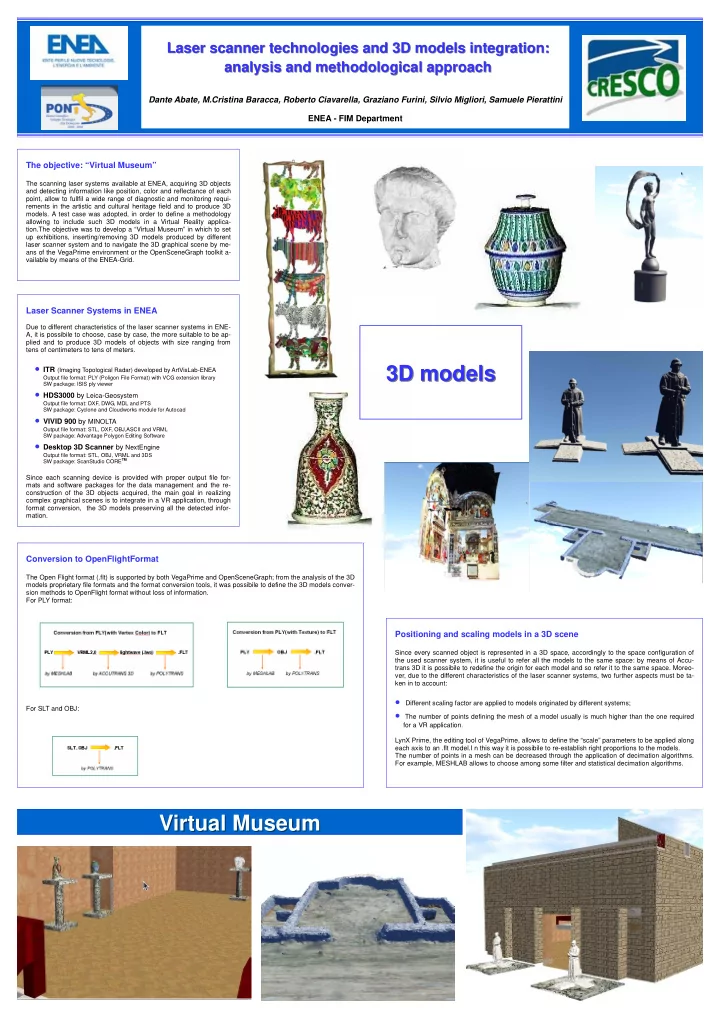

Laser scanner technologies and 3D models integration: Laser scanner technologies and 3D models integration: analysis and methodological approach analysis and methodological approach Dante Abate, M.Cristina Baracca, Roberto Ciavarella, Graziano Furini, Silvio Migliori, Samuele Pierattini ENEA - FIM Department The objective: “Virtual Museum” The scanning laser systems available at ENEA, acquiring 3D objects and detecting information like position, color and reflectance of each point, allow to fullfil a wide range of diagnostic and monitoring requi- rements in the artistic and cultural heritage field and to produce 3D models. A test case was adopted, in order to define a methodology allowing to include such 3D models in a Virtual Reality applica- tion.The objective was to develop a “Virtual Museum” in which to set up exhibitions, inserting/removing 3D models produced by different laser scanner system and to navigate the 3D graphical scene by me- ans of the VegaPrime environment or the OpenSceneGraph toolkit a- vailable by means of the ENEA-Grid. Laser Scanner Systems in ENEA Due to different characteristics of the laser scanner systems in ENE- A, it is possibile to choose, case by case, the more suitable to be ap- plied and to produce 3D models of objects with size ranging from tens of centimeters to tens of meters. • ITR (Imaging Topological Radar) developed by ArtVisLab-ENEA 3D models 3D models Output file format: PLY (Poligon File Format) with VCG extension library SW package: ISIS ply viewer • HDS3000 by Leica-Geosystem Output file format: DXF, DWG, MDL and PTS SW package: Cyclone and Cloudworks module for Autocad • VIVID 900 by MINOLTA Output file format: STL, DXF, OBJ,ASCII and VRML SW package: Advantage Polygon Editing Software • Desktop 3D Scanner by NextEngine Output file format: STL, OBJ, VRML and 3DS SW package: ScanStudio CORE TM Since each scanning device is provided with proper output file for- mats and software packages for the data management and the re- construction of the 3D objects acquired, the main goal in realizing complex graphical scenes is to integrate in a VR application, through format conversion, the 3D models preserving all the detected infor- mation. Conversion to OpenFlightFormat The Open Flight format (.flt) is supported by both VegaPrime and OpenSceneGraph; from the analysis of the 3D models proprietary file formats and the format conversion tools, it was possibile to define the 3D models conver- sion methods to OpenFlight format without loss of information. For PLY format: Positioning and scaling models in a 3D scene Since every scanned object is represented in a 3D space, accordingly to the space configuration of the used scanner system, it is useful to refer all the models to the same space: by means of Accu- trans 3D it is possibile to redefine the origin for each model and so refer it to the same space. Moreo- ver, due to the different characteristics of the laser scanner systems, two further aspects must be ta- ken in to account: • Different scaling factor are applied to models originated by different systems; For SLT and OBJ: • The number of points defining the mesh of a model usually is much higher than the one required for a VR application. LynX Prime, the editing tool of VegaPrime, allows to define the “scale” parameters to be applied along each axis to an .flt model.I n this way it is possibile to re-establish right proportions to the models. The number of points in a mesh can be decreased through the application of decimation algorithms. For example, MESHLAB allows to choose among some filter and statistical decimation algorithms. Virtual Museum Virtual Museum
Fig.3 Benefits of multicluster queue.
ENEA-FIM, C.R. Portici
References http://www.cresco.enea.it/LA1/cresco_ sp12_graf3d/
Recommend
More recommend